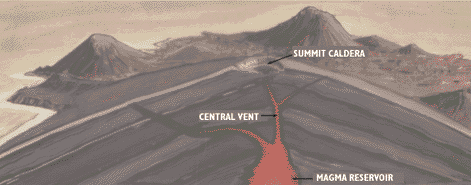
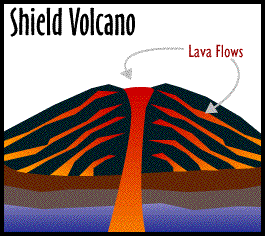
Types of volcanic structures
As a first classification we shall consider the common forms of volcano associated with basic lava, acid lava, scoria eruption and mixed eruption.
Basic lavas are characteristically very fluid, so spread easily and give rise typically to volcanoes of low gradient.
Shield volcanoes/Lava shields-- These convex outlined volcanoes are mostly built by repeated outpourings of basaltic lava, a type of lava that is very fluid when erupted, and then cool as thin, gently dipping sheets. Therefore, they are the largest type of volcanoes on Earth (not counting flood basalt flows).
This type of volcano can be hundreds of miles across and many tens of thousands of feet high. The Hawaiian volcanoes are the most famous and classic examples. The individual islands of the state of Hawaii are simply large shield volcanoes. Mauna Loa, a shield volcano on the "big" island of Hawaii, is the largest single mountain and one of the most active volcanoes on Earth, rising over 30,000 feet above the ocean floor and reaching almost 100 miles across at its base. Shields of this size are made up of a number of separate volcanoes, for instance Kilauea and Hualalai are mere flank volcanoes on Mauna Loa. Volcanic masses such as the island of Hawaii, formed by the overlapping of a group of shield volcanoes, may be termed volcanic shield-clusters.
Lava commonly erupt from vents along fractures (rift zones) that develop on the flanks of the cone. Sometimes, basaltic lava pours out quietly from long fissures instead of central vents and floods the surrounding countryside with lava flow upon lava flow forming broad plateaus. These volcanoes have low slopes (less than 7°) because a fluid that easily runs downhill cannot be piled up. They are only explosive if water somehow gets into the vent, otherwise they are characterized by low-explosivity fountaining that forms cinder cones and spatter cones at the vent, however, 95% of the volcano is lava rather than pyroclastic material.
Shield volcanoes are the common product of hotspot volcanism but they can also be found along subduction-related volcanic arcs and out by themselves as well. They almost always have large craters at their summits. Parasitic cones, flank eruptions, and fissure eruptions are commonly associated with shield volcanoes. 'Shield volcano' is a less exact term that usually refers to a lava shield, but may be used for a large strato-volcano or volcanic complex.


The internal structure of a typical shield volcano.
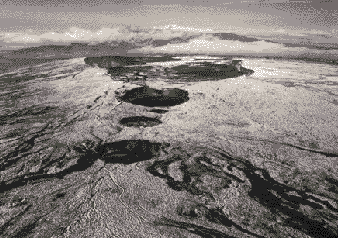 Mauna
Loa, a giant among the active volcanoes on Earth
Mauna
Loa, a giant among the active volcanoes on Earth
Lava domes--
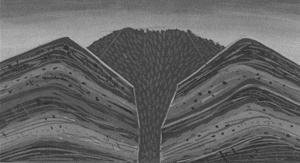 Schematic
representation of the internal structure of a typical volcanic dome.
Schematic
representation of the internal structure of a typical volcanic dome.
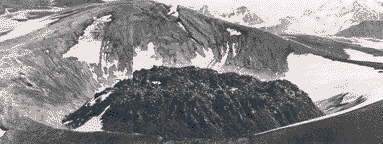
Novarupta Dome formed during the 1912 eruption of Katma Volcano, Alaska.
Mont Pelée in Martinique, Lesser Antilles, and Lassen Peak and Mono domes in California are examples of lava domes. An extremely destructive eruption accompanied the growth of a dome at Mont Pelée in 1902. The coastal town of St. Pierre, about 4 miles downslope to the south, was demolished and nearly 30,000 inhabitants were killed by an incandescent, high-velocity ash flow and associated hot gases and volcanic dust. Only two men survived; one because he was in a poorly ventilated, dungeon-like jail cell and the other who somehow made his way safely through the burning city.
Flood basalt provinces-- This is another strange type of "volcano". Some parts of the world are covered by thousands of square kilometers of thick basalt lava flows--some flows are more than 50 meters thick, and individual flows extend for hundreds of kilometers. The old idea was that these flows went whooshing over the countryside at incredible velocities. The new idea is that these flows are emplaced more like pahoehoe flows--slow moving, with most of the great thickness being accomplished by injecting lava into the interior of an initially thin flow. The most famous U.S. example of a flood basalt province is the Columbia River Basalts, covering most of SE Washington State, and extending all the way to the Pacific and into Oregon. The Deccan Traps of northwest India are a much larger flood basalt province.
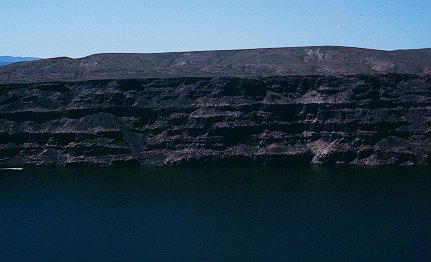
Cross-sectional view of lava flows of the Columbia River flood basalts, part of the lava plains of the western United States.
Mid-ocean ridge volcanism-- They occur at plate margins where oceanic plates are created. There is a system of mid-ocean ridges more than 70,000 km long that stretches through all the ocean basins. Some people consider this as the largest volcano on Earth. There, the plates are pulled apart by convection in the upper mantle, and basalt lava intrudes to the surface to fill in the space or, the basalt intrudes to the surface and pushes the plates apart or, it is a combination of these two processes. Either way, this is how the oceanic plates are created.
Lava cones-- Central eruption on a still smaller scale may give rise to simple straight-sided cones built of successive lava flows, such as Mt Hamilton, Victoria. These usually have flanks of low angle (7º or less), but some examples are much steeper.
Beerenberg on the Arctic island of Jan Mayen, for example, consists of a broad basalt lava dome some 15-24 km in diameter at sea level, on the crest of which is a lava cone with steep 450 slopes, some 5 km in diameter and 750 m high (Fitch, 1964). In the Victorian volcanic province a final stage of scoria eruption often obliterates lava cones formed earlier. In Iceland a rim of scoria round the crater is charactenstic. The Kolotta Dyngja, a typical Icelandic volcano, rises to a height of 460 m with an average slope of 70, approaching 80 towards the summit. The volcano has a diameter of 5 km and the crater a diameter of 550 m. A ring of scoria about 15 m high surrounds the crater, and has slopes of up to 30 degrees.
 The
cross-section of a lava cone.
The
cross-section of a lava cone.
Lava mounds-- Some basaltic volcanoes have no sign of a crater, but are gently sloping mounds, such as Mt Cotterill, Victoria. These extinct volcanoes may owe their shape partly to erosion, although they probably never had very pronounced craters but had lava welling right to the brim before solidification. Such volcanoes, distinguished from cones by their lack of crater, may be termed lava mounds by analogy with scoria mounds.
![]() The
cross-section of a lava mound.
The
cross-section of a lava mound.
Lava disc-- In Victoria there are a few anomalous volcanoes which have been described as lava discs. They are made of basalt, and display jointing perpendicular to the lava skin on both the upper surface and the sides. The smallest one, Lawaluk, has the form of a steep-edged, flat-topped disc of basalt. Mondilibi is probably of the same type, and the main lava sheet within the ring barrier of Mt Porndon appears to be a similar feature though larger (3 km in diameter). These hills appear to be made by eruption of single flows that develop a tough skin and spread out from the centre without breaking the skin, in the manner of a water-filled balloon collapsing into a disc.
![]() The
cross-section of a lava disc.
The
cross-section of a lava disc.
Acid igneous rocks are generally very viscous, and if they do not explode their lack of flow gives rise to a number of distinctive landforms.
Cumulo-domes-- When viscous lava is extruded, it sags and spreads into convex dome-like bodies called cumulo-domes. These may be almost independent, or may be associated with and partly intrusive into previously deposited pyroclasts. The main part of Lassen Peak, California, is a large-scale example, rising 800 m above pyroclastics and having a diameter of 2.5 km.
Sometimes several cumulo-domes may coalesce. Tauhara in New Zealand is a multiple volcano of late Pleistocene age consisting of five coalescing dacite cumulo-domes. Internal flow structures suggest that each dome was formed from lava continuously extruded, but each had a separate vent. The Tarawera Rift explosion of 1886 exposed excellent sections through a number of domes, enabling a better interpretation of internal structure than is usually possible. There is well-developed circular jointing at the centre of domes, becoming vertical towards the edge and in the coulees. The tops of both domes and coulees are very irregular due to fissuring.
The puys or volcanic hills of the Puy-de-Dome landscape of Auvergne are typically scoria cones with craters, but some, such as the craterless Grand Sarcoui, are trachytic cumulo-domes, and the term puy is occasionally and unfortunately used to mean cumulo-dome.
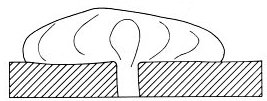 The
cross-section of a cumulo-dome.
The
cross-section of a cumulo-dome.
Plug domes/necks-- In its most viscous form, the magma extruded from a vent may be so rigid that it moves up like a piston, along with fragmental volcanic and wallrock materials, producing a roughly cylindrical body known as a plug dome. Plug domes can grow rapidly, but during growth they are shattered by explosions and broken by uneven growth, and the accumulation of broken spines and extrusion ridges causes many plug domes to be covered by a jumble of debris. They may be visualized as the fossil remains of the innards of a volcano (the so-called "volcanic plumbing system"). The igneous material in a plug may have a range of composition similar to that of associated lavas or ash, but may also include fragments and blocks of denser, coarser grained rocks ( higher in iron and magnesium, lower in silicon) thought to be samples of the Earth's deep crust or upper mantle plucked and transported by the ascending magma. Many plugs and necks are largely or wholly composed of fragmental volcanic material and of fragments of wallrock, which can be of any type. Plugs that bear a particularly strong imprint of explosive eruption of highly gas-charged magma are called diatremes or tuff-breccia.
Volcanic plugs are believed to overlie a body of magma which could be either still largely liquid or completely solid depending on the state of activity of the volcano. Plugs are known, or postulated, to be commonly funnel shaped and to taper downward into bodies increasingly elliptical in plan or elongated to dike-like forms. Typically, volcanic plugs and necks tend to be more resistant to erosion than their enclosing rock formations. Thus, after the volcano becomes inactive and deeply eroded, the exhumed plug may stand up in bold relief as an irregular, columnar structure. One of the best known and most spectacular diatremes in the United States is Ship Rock in New Mexico, which towers some 1,700 feet above the more deeply eroded surrounding plains. Volcanic plugs, including diatremes, are found elsewhere in the western United States and also in Germany, South Africa, Tanzania, and Siberia.
In American usage plug dome may refer to what are here called cumulo-domes. In New Zealand, Mt Edgecumbe is an andesite volcano that was apparently extruded through a jagged orifice, for it has grooves on the side and top that are not due to erosion, but are giant scratches. The Pitons of Carbet, Martinique, are thought to be plug domes, and Merapi, Indonesia, is an active volcano which builds successive plug domes that are explosively destroyed.
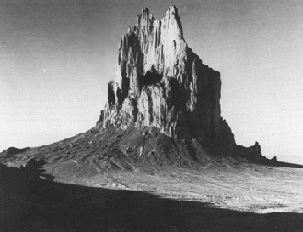 Ship Rock in San Juan County, New Mexico.
Ship Rock in San Juan County, New Mexico.
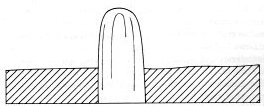 The
cross-section of a plug-dome.
The
cross-section of a plug-dome.
Spines-- Whereas plug domes are large bodies of nearly mountain size, smaller-scale extrusion of very rigid lava, through chinks in the cracked skin of plug domes or cumulo-domes, gives rise to spines. The spine of Mont Pelée, Martinique, which was produced after the catastrophic eruption of 1902, reached a height of over 300 m, but was rapidly eroded. At one stage it grew 13 m in a day. Spines are frequently irregular in shape, and are not extruded uniformly as cylindrical pillars. A spine on Santa Maria, Guatemala, that grew between 1922 and 1925, reached a maximum size of 500m high and 1300m across the base.
When explosively produced fragments of lava fall around a volcanic vent they build up a heap of debris, the slope of which depends on the angle of rest of the fragments concerned. Fine particles have lower slopes than coarse ones, and as the coarser fragments tend to accumulate near the vent, beautiful concave slopes are formed, like those of Fujiyama and Mt Egmont.
Stratovolcanoes/Composite volcanoes-- They make up the largest percentage (~60%) of the Earth's volcanoes and are commonly found along subduction-related volcanic arcs. They are typically steep-sided, symmetrical cones of large dimension built of alternating layers of lava flows, volcanic ash, cinders, blocks, and bombs and may rise as much as 8,000 feet above their bases. They are characterized by eruptions of cooler and more viscous lavas than basalt. Lava called andesite, dacite and rhyolite either flow through breaks in the crater wall or issue from fissures on the flanks of the cone. These more viscous lavas allow gas pressures to build up to high levels (they are effective "plugs" in the plumbing), therefore these volcanoes often suffer explosive eruptions. The lava which solidified within the fissures forms dikes that act as ribs which greatly strengthen the cone. Stratovolcanoes are usually about 50/50 solid lava and pyroclastic deposits. The layering of these products gives them their other common name of composite volcanoes. They sometimes have small craters in their summits, which contains a central vent or a clustered group of vents. In fact, many of these volcanoes have erupted over a long period, and they the commonest form developed by long-lived central volcanoes.
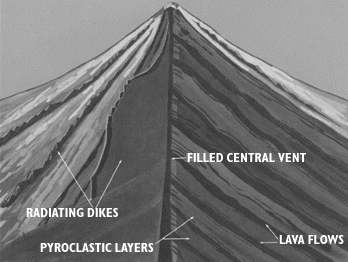
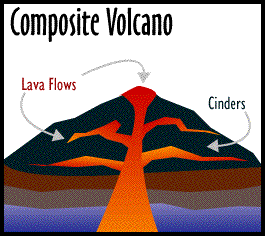
Schematic representation of the internal structue of a typical composite volcano.
When a composite volcano becomes dormant, erosion begins to destroy the cone. As the cone is stripped away, the hardened magma filling the conduit (the volcanic plug) and fissures (the dikes) becomes exposed, and it too is slowly reduced by erosion. Finally, all that remains is the plug and dike complex projecting above the land surface--a telltale remnant of the vanished volcano.
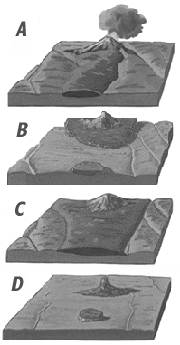
A. Magma, rising upward through a conduit, erupts at the Earth's surface to form a volcanic cone. Lava flows spread over the surrounding area. (See animation)
B. As volcanic activity continues, perhaps over spans of hundreds of years, the cone is built to a great height and lava flows form an extensive plateau around its base. During this period, streams enlarge and deepend their valleys.
C. When volcanic activity ceases, erosion starts to destroy the cone. After thousands of years, the great cone is stripped away to expose the hardened "volcanic plug" in the conduit. During this period of inactivity, streams broaden their valleys and dissect the lava plateau to form isolated lava-capped mesas.
D. Continued erosion removes all traces of the cone and the land is worn down to a surface of low relief. All that remains is a projecting plug or "volcanic neck," a small lava-capped mesa, and vestiges of the once lofty volcano and its surrounding lava plateau.
Large rhyolite caldera complexes-- They are the most explosive of Earth's volcanoes. These volcanoes, which are simply circular depressions, often don't even look like volcanoes. They are usually so explosive when they erupt that they end up collapsing in on themselves and spewing volcanic rocks out hundreds or even a thousand miles in all directions rather than building any tall structure (see animation). The collapsed depressions are called calderas, and they indicate that the magma chambers associated with the eruptions are huge. Sometimes the calderas are so filled with lava and volcanic ash that there is no recognizable depression at all. These can only be found by carefully locating the big fractures or "faults" in the ground that mark the edges of the caldera. Fortunately we haven't had to live through one of these since 83 AD when Taupo erupted. Yellowstone is the most famous U.S. example of one of these. Their origin is still not well-understood. Many people think that Yellowstone is associated with a hotspot. However, a hotspot association with most other rhyolite calderas doesn't work.
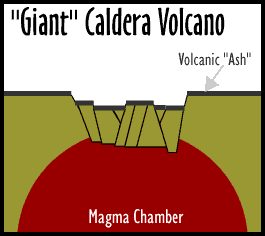 The
internal structure of a "giant" caldera volcano .
The
internal structure of a "giant" caldera volcano .
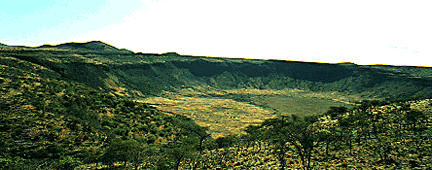
View
into the floor of a young maar volcano
on the Ethiopia/Kenya border. The mega volcanic field includes a number of maars
that cut through ancient crystalline rock. Like many maars, this one has
collapsed so that its floor is lower than the surrounding plain. If this area
did not have a desert climate, the maar would probably contain a lake. This
photo is by
Chuck Wood, 1972.
Scoria cone-- The ideal scoria cone is single, steep, with straight or gently concave sides, and with a crater at the top. Mt Elephant, Victoria, 240 m high, is a good example. The even height of the crater rim often causes scoria cones to appear flat-topped when viewed from a distance. Scoria cones may be built very rapidly. Monte Nuovo near Naples, Italy, was built to a height of 130 m in a single eruption lasting a few days in 1538. Barcena, on the island of San Benedicto, Mexico, built a cone of 300m in twelve days in 1952. In the last stages of eruption basaltic magma tends to build up scoria cones. Thus in Victoria there are far more scoria cones than other types of volcano, though the province as a whole is dominated by flows of basic lava.
![]() The
cross-section of a scoria cone.
The
cross-section of a scoria cone.
Scoria mound-- Some scoria volcanoes have no apparent crater and may be termed scoria mounds to distinguish them from normal scoria cones. The Anakies, Victoria, are examples.
 The
cross-section of a scoria mound.
The
cross-section of a scoria mound.
Nested scoria cones-- Scoria cones are frequently produced as the last phase of an eruption on the site of larger volcanoes of other type. When they are in the centre of a large crater or caldera they are called nested cones. The V-sectioned trough between the inner cone and the crater wall is called a fosse.
 The
cross-section of a nested scoria cone.
The
cross-section of a nested scoria cone.
Maars/Tuff rings/Tuff cones-- Maars are shallow, flat-floored landforms caused by volcanic explosion and consist of a crater which extends below general ground level and is considerably wider than deep, and a surrounding rim constructed of material ejected from the crater. The rim consists of pyroclastic material, either igneous or comminuted bedrock, and is often markedly asymmetrical, with greater deposition on the downwind side of the crater. Deep erosion of a maar presumably would expose a diatreme. The rim deposit is also asymmetrical in cross section, with a steep side towards the crater, and a gentle slope (commonly 40° or less) away from the crater, parallel to the bedding of the pyroclastics. The craters have a diameter often about 1 km and the rims are commonly less than 50 m high (although they may reach 100 m) because the rims are composed of loose fragments of volcanic rock and rocks torn from the walls of the diatreme. They are mostly filled with water to form natural lakes.
Maars occur in the western United States, in the Eifel region of Germany, and in other geologically young volcanic regions of the world. An excellent example of a maar is Zuni Salt Lake in New Mexico, a shallow saline lake that occupies a flat-floored crater about 6,500 feet across and 400 feet deep. Its low rim is composed of loose pieces of basaltic lava and wallrocks (sandstone, shale, limestone) of the underlying diatreme, as well as random chunks of ancient crystalline rocks blasted upward from great depths.
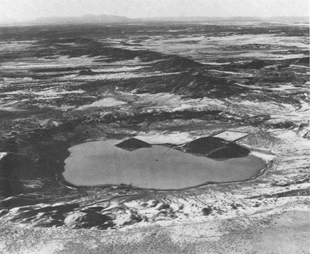 Zuni
Salt Lake Maar in New Mexico.
Zuni
Salt Lake Maar in New Mexico.
![]() The
cross-section of a maar
The
cross-section of a maar
Littoral cones-- When aa lava reaches the sea it explodes and the ejecta pile up to form a cone up to 100 m high and 1 km in diameter. There is often a double hill, one hill built on each side of the lava stream (Wentworth and Macdonald, 1953).
Mixed eruption volcanoes
In many volcanoes there is a mixture of lava and fragmental deposits.
Cinder cones-- Cinder cones are the simplest type of volcano. As you might expect from the name, these volcanoes consist almost entirely of loose, grainy cinders and almost no lava. They are built from particles and blobs of congealed lava ejected from a single vent. As the gas-charged lava is blown violently into the air, it breaks into small fragments that solidify and fall as cinders around the vent to form a circular or oval cone. They are small volcanoes, usually only about a mile across and rarely rise more than a thousand feet or so above their surroundings. They have very steep sides and usually have a small bowl-shaped crater at the summit. Cinder cones are numerous in western North America as well as throughout other volcanic terrains of the world.
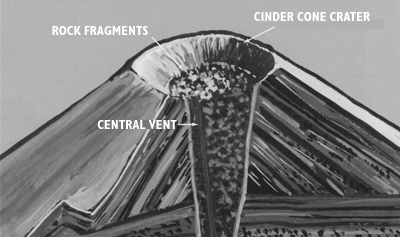
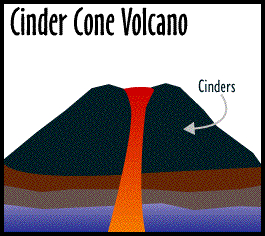
Schematic representation of the internal structure of a typical cinder cone.
In 1943 a cinder cone started growing on a farm near the village of Parícutin in Mexico. Explosive eruptions caused by gas rapidly expanding and escaping from molten lava formed cinders that fell back around the vent, building up the cone to a height of 1,200 feet. The last explosive eruption left a funnel-shaped crater at the top of the cone. After the excess gases had largely dissipated, the molten rock quietly poured out on the surrounding surface of the cone and moved downslope as lava flows. This order of events--eruption, formation of cone and crater, lava flow--is a common sequence in the formation of cinder cones. During 9 years of activity, Parícutin built a prominent cone, covered about 100 square miles with ashes, and destroyed the town of San Juan. Geologists from many parts of the world studied Parícutin during its lifetime and learned a great deal about volcanism, its products, and the modification of a volcanic landform by erosion.
Parasitic cones/Adventive cones/Secondary cones-- When a volcano becomes very high, very great pressure is required for the rising lava to reach the summit crater. It is sometimes possible for the lava to find an easier route to the surface, and erupt on the flanks of the main volcano. Once such an eruption has taken place, the solidified lava in the conduit plugs that outlet, and in succeeding eruption another opening must be made. In this manner large volcano comes to have many small parasitic cones on its flanks. Mt Etna, Sicily, with over two hundred parasitic cones and over eight hundred small mounds of lava known as boccas, is the finest example. Here each new series of eruptions occurs along a rift, and succeeding new cones appear higher and higher up the fissure until it is sealed.
Multiple cones-- In some areas, as, for instance, on the volcanic plains of Victoria, a number of scoria cones are built very close together. The general mechanism appears to be the same as for parasitic cones, that is the first cone blocks the vent, and the second one occurs on a new vent close by. The difference here is that no cones grow to any great size, and all the separate cones tend to be of about the same size; that is there is no main volcano with parasites, but a series of equal volcanoes. These may be called multiple cones.
Others
Monogenetic
fields-- These volcanoes also don't look like a
"volcano", rather they are a collection of sometimes hundreds to
thousands of separate vents and flows. These are the product of very low supply
rates of magma. The supply rate is so slow and spread out that between the times
of eruptions the plumbing doesn't stay hot so the next batch of magma doesn't
have any preferred pathway to the surface and it makes its own path. A
monogenetic field is kind of like taking a single volcano and spreading all its
separate eruptions over a large area. There are a number of monogenetic fields
in the American southwest, and there is a famous one in Mexico called the
Michoacan-Guanajuato field.
Fissure volcano-- This type of volcano has no central crater at all, which makes it difficult to recognize either from the ground or from space. Instead, giant cracks open in the ground and expel vast quantities of lava that spread far and wide to form huge pools that can cover almost everything around. When these pools of lava cool and solidify, the surface remains mostly flat and they become flat plains. Since the source cracks are usually buried, there is often nothing "volcano-like" to see.
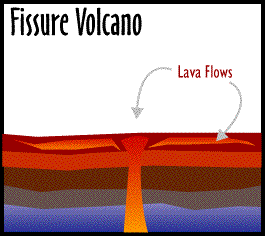 The internal structure
of a fissure volcano.
The internal structure
of a fissure volcano.
Ice Volcanoes of Lake Superior's South Shore-- Ice volcanoes commonly occur during the winter months along the north shore of Lake Superior. Cones begin to form at the leading edge of the ice shelf as it builds out into the lake. When the waves, driven by strong onshore winds, feel bottom they build and break onto the ice shelf. After the ice shelf has built out, waves continue to travel underneath the ice and are forced up through cracks and previously formed cones.
Submarine Volcanoes
The unlimited supply of water surrounding submarine volcanoes can cause them to behave differently from volcanoes on land. Violent, steam-blast eruptions take place when sea water pours into active shallow submarine vents. Lava, erupting onto a shallow sea floor or flowing into the sea from land, may cool so rapidly that it shatters into sand and rubble. The result is the production of huge amounts of fragmental volcanic debris. The famous "black sand" beaches of Hawaii were created virtually instantaneously by the violent interaction between hot lava and sea water. On the other hand, recent observations made from deep-diving submersibles have shown that some submarine eruptions produce flows and other volcanic structures remarkably similar to those formed on land. Recent studies have revealed the presence of spectacular, high temperature hydrothermal plumes and vents (called "smokers") along some parts of the mid-oceanic volcanic rift systems. However, to date, no direct observation has been made of a deep submarine eruption In progress.
During an explosive submarine eruption in the shallow open ocean, enormous piles of debris are built up around the active volcanic vent. Ocean currents rework the debris in shallow water, while other debris slumps from the upper part of the cone and flows into deep water along the sea floor. Fine debris and ash in the eruptive plume are scattered over a wide area in airborne clouds. Coarse debris in the same eruptive plume rains into the sea and settles on the flanks of the cone. Pumice from the eruption floats on the water and drifts with the ocean currents over a large area.
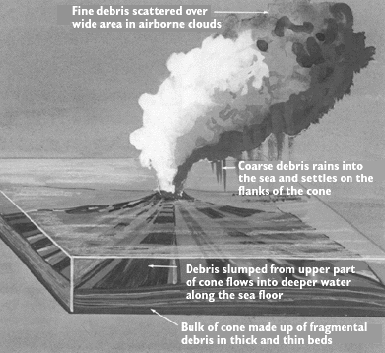
Schematic representation of a typical submarine eruption in the open ocean.
Geysers, Fumaroles, and Hot Springs
Geysers, fumaroles (also called solfataras), and hot springs are generally found in regions of young volcanic activity. Surface water percolates downward through the rocks below the Earth's surface to high-temperature regions surrounding a magma reservoir, either active or recently solidified but still hot. There the water is heated, becomes less dense, and rises back to the surface along fissures and cracks. Sometimes these features are called "dying volcanoes" because they seem to represent the last stage of volcanic activity as the magma, at depth, cools and hardens.
Erupting geysers provide spectacular displays of underground energy suddenly unleashed, but their mechanisms are not completely understood. Large amounts of hot water are presumed to fill underground cavities. The water, upon further heating, is violently ejected when a portion of it suddenly flashes into steam. This cycle can be repeated with remarkable regularity, as for example, at Old Faithful Geyser in Yellowstone National Park, which erupts on an average of about once every 65 minutes.
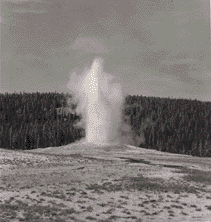 Old
Faithful Geyser, Yellowstone National Park, Wyoming.
Old
Faithful Geyser, Yellowstone National Park, Wyoming.
Fumaroles are vents from which volcanic gas escapes into the atmosphere.
Fumaroles may occur along tiny cracks or long fissures, in chaotic
clusters or fields, and on the surfaces of lava flows and thick deposits
of pyroclastic flows. They may persist for decades or centuries if they
are above a persistent heat source or disappear within weeks to months
if they occur atop a fresh volcanic deposit that quickly cools.
Hot springs occur in many thermal areas where the surface of the Earth intersects the water table. The temperature and rate of discharge of hot springs depend on factors such as the rate at which water circulates through the system of underground channelways, the amount of heat supplied at depth, and the extent of dilution of the heated water by cool ground water near the surface.
Extraterrestrial Volcanism
Volcanoes and volcanism are not restricted to the planet Earth. Manned and unmanned planetary explorations, beginning in the late 1960's, have furnished graphic evidence of past volcanism and its products on the Moon, Mars, Venus and other planetary bodies. Many pounds of volcanic rocks were collected by astronauts during the various Apollo lunar landing missions. Only a small fraction of these samples have been subjected to exhaustive study by scientists. The bulk of the material is stored under controlled-environment conditions at NASA's Lunar Receiving Laboratory in Houston, Tex., for future study by scientists.
From the 1976-1979 Viking mission, scientists have been able to study the volcanoes on Mars, and their studies are very revealing when compared with those of volcanoes on Earth. For example, Martian and Hawaiian volcanoes closely resemble each other in form. Both are shield volcanoes, have gently sloping flanks, large multiple collapse pits at their centers, and appear to be built of fluid lavas that have left numerous flow features on their flanks. The most obvious difference between the two is size. The Martian shields are enormous. They can grow to over 17 miles in height and more than 350 miles across, in contrast to a maximum height of about 6 miles and width of 74 miles for the Hawaiian shields.
Voyager-2 spacecraft captured volcanoes in the actual process of eruption on Lo, a moon of Jupiter. The volcanic plumes rise some 60 to 100 miles above the surface of the moon. Thus, active volcanism is taking place, at present, on at least one planetary body in addition to our Earth.
An active volcano is one that has erupted sometime during the last few hundred years.
A dormant volcano is one that has not erupted during the last few hundred years, but it has erupted during the last several thousand years. When magma from the Earth's mantle can no longer reach the volcano, for example, in Hawaii, the line of islands is slowly moving to the northwest. Meanwhile, the supply of magma stays in the same place within the Earth, which now happens to lie beneath the Big Island. As the islands move away from the supply of magma, volcanoes become dormant, and new volcanoes form over the magma supply.
An extinct volcano is one that has not erupted during the last several thousand years.